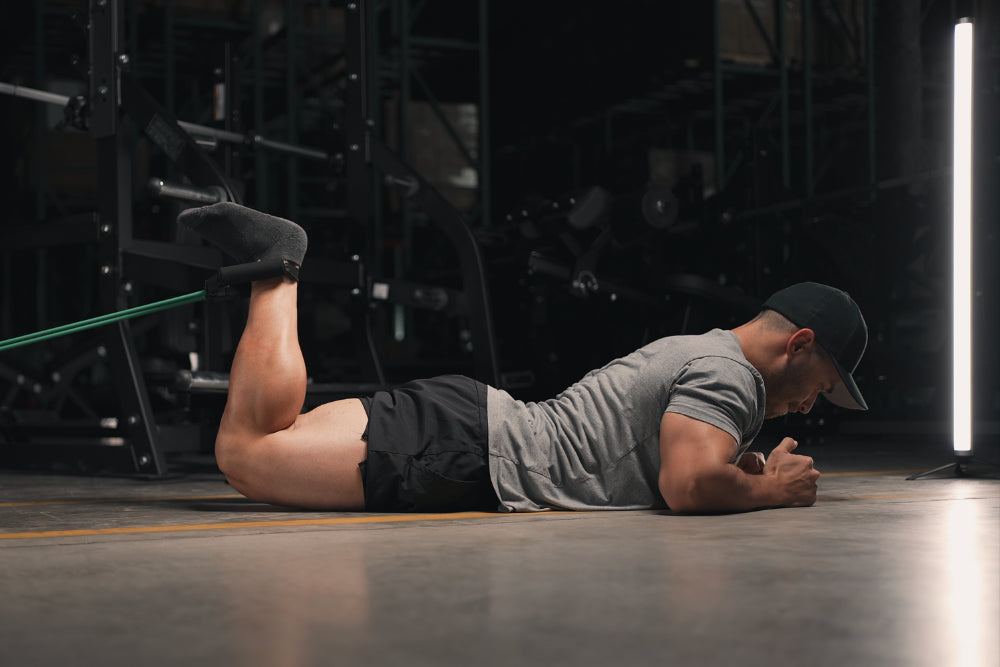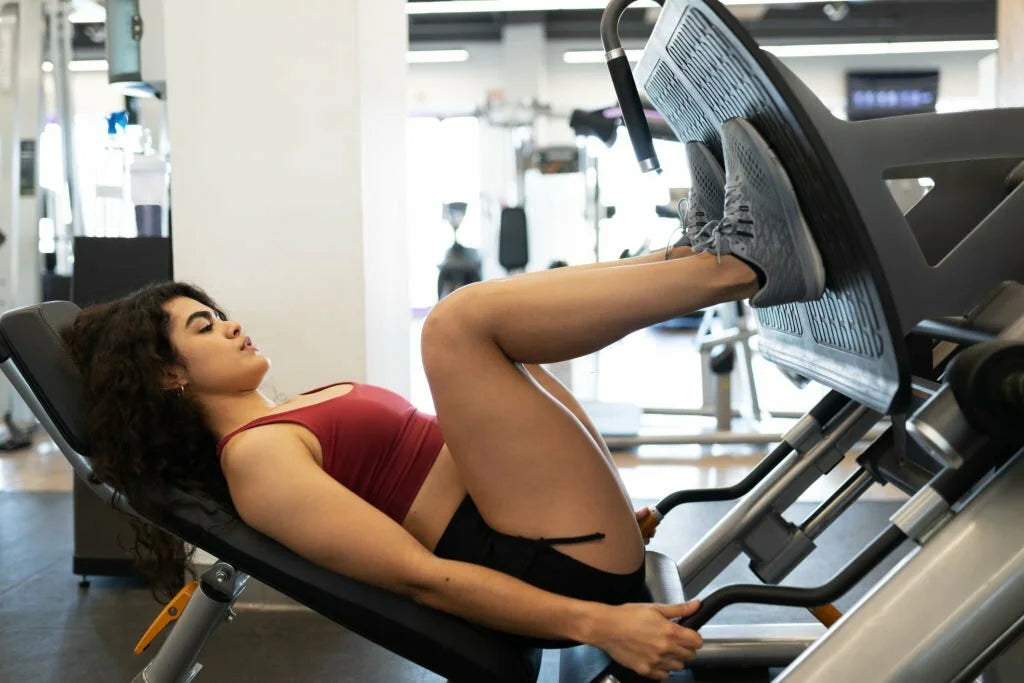7 exercices pour renforcer les ischio-jambiers


Que vous soyez athlète, culturiste ou habitué des salles de sport, négliger ses ischio-jambiers est risqué. En tant qu'ancien coach sportif, j'ai constaté de nombreuses blessures aux ischio-jambiers. En fait, la faiblesse des ischio-jambiers est l'une des principales causes de blessures sur le terrain.
Heureusement, travailler les ischio-jambiers n'est pas forcément compliqué. En fait, un entraînement efficace des ischio-jambiers peut être réalisé avec seulement un jeu de bandes de résistance à vingt dollars. Cet article vous explique comment y parvenir. Nous vous présenterons les sept meilleurs exercices avec bandes pour les ischio-jambiers à faire à la maison et vous donnerons des conseils d'experts pour optimiser vos séances.
Anatomie et fonction des ischio-jambiers
Les ischio-jambiers sont un groupe de trois muscles principaux situés à l'arrière de la cuisse : le biceps fémoral, le semi-tendineux et le semi-membraneux. Ces muscles naissent de l'os iliaque et s'insèrent sur le tibia et le péroné sous le genou, traversant les articulations de la hanche et du genou.
Les ischio-jambiers jouent un rôle essentiel dans l'extension de la hanche, permettant de déplacer la cuisse vers l'arrière. Ce mouvement est particulièrement important dans des activités comme la course, le sprint et le saut.
Une autre fonction essentielle des ischio-jambiers est la flexion du genou, qui permet de le plier. Cette action est impliquée dans des activités comme la marche, la montée des escaliers et les squats.
Le biceps fémoral, l'un des muscles ischio-jambiers, contribue également à la rotation de la jambe, aidant à des mouvements tels que le pivotement pendant le sport ou la torsion pendant les activités quotidiennes.
Au-delà du mouvement, les ischio-jambiers stabilisent les articulations de la hanche et du genou, assurant un alignement correct et empêchant les mouvements excessifs qui pourraient entraîner des blessures.
Lors d’activités physiques impliquant un mouvement vers l’avant, comme la course à pied ou le vélo, les ischio-jambiers aident à ralentir le mouvement des jambes pour contrôler la vitesse et prévenir les blessures.
Importance et avantages des exercices de renforcement des ischio-jambiers
Les bandes de résistance offrent un moyen économique de travailler vos muscles contre résistance. Elles vous permettent de simuler un équipement de sport encombrant et coûteux, comme un appareil de flexion des jambes, pour quelques euros seulement, et en toute sécurité. Voici quatre avantages spécifiques à l'utilisation de bandes pour l'entraînement des ischio-jambiers :
Meilleure activation musculaire
Les bandes de résistance offrent une tension variable et continue, améliorant ainsi l'activation des ischio-jambiers. Cette tension force vos muscles à travailler davantage à chaque répétition, favorisant ainsi une meilleure croissance musculaire et des résultats plus importants en termes de force.
Gain musculaire et de force
L'utilisation de bandes de résistance pour les exercices des ischio-jambiers peut entraîner une hypertrophie musculaire et un gain de force. Elles permettent de surcharger progressivement les muscles, un facteur essentiel à l'adaptation musculaire.
Plusieurs options d'exercices
Grâce aux bandes de résistance, vous disposez d'un large éventail d'options d'exercices pour tous les principaux groupes musculaires, y compris les ischio-jambiers. Cette variété rend vos entraînements stimulants et efficaces.
Entraînements pratiques partout
Les bandes de résistance sont portables, ce qui facilite le travail des ischio-jambiers à la maison, en extérieur ou en voyage. Cette commodité vous permet de maintenir une routine d'entraînement régulière.
7 meilleurs exercices pour les ischio-jambiers avec bande
Flexion des ischio-jambiers allongée avec bande de résistance
Pour réaliser un curlischio-jambiers allongé avec bande élastique, vous aurez besoin d'une bande de résistance et d'un point d'ancrage stable, comme un poteau solide ou une barre. Commencez par fixer une extrémité de la bande de résistance au point d'ancrage au niveau du sol.
Guide étape par étape :
- Allongez-vous sur le ventre sur une surface plane, en veillant à ce que vos hanches et l'avant de vos cuisses soient en contact avec le sol. Tendez complètement vos jambes en les gardant jointes.
- Accrochez l'autre extrémité de la bande de résistance à l'un de vos talons. Assurez-vous qu'elle est bien fixée.
- Commencez le mouvement de flexion en fléchissant le genou et en tirant le talon vers les fesses grâce à la résistance de la bande. Pendant que vous fléchissez la jambe, maintenez le contact avec le sol avec vos hanches et vos cuisses.
- Continuez à courber votre jambe jusqu’à ce qu’elle atteigne son amplitude de mouvement maximale et que vous ressentiez une forte contraction dans vos muscles ischio-jambiers.
- De manière contrôlée, tendez le genou pour ramener la jambe à sa position initiale. Continuez à résister à la traction de la bande.
Soulevé de terre roumain avec bande de résistance
Choisissez une bande de résistance adaptée à votre niveau de force pour le soulevé de terre. La bande doit offrir une résistance suffisante pour solliciter vos muscles, sans être trop lourde pour compromettre votre technique. Placez la bande au sol et posez vos pieds au centre. Vous obtiendrez ainsi deux boucles qui serviront de poignées.
Guide étape par étape :
- Tenez-vous debout, les pieds écartés au maximum à la largeur des hanches. Contrairement au soulevé de terre traditionnel, la position est plus étroite tout au long de l'exercice.
- Tenez chaque extrémité de la bande, paumes tournées vers le corps, et levez-vous. C'est la position de départ du soulevé de terre roumain avec bande de résistance.
- Commencez le mouvement en poussant vos fesses vers l'arrière, initiant ainsi une charnière de hanche. Ce mouvement permet à vos hanches de reculer tout en gardant votre dos droit. Assurez-vous que vos épaules sont bien en arrière et que votre colonne vertébrale reste en position neutre.
- Lorsque vous vous penchez au niveau des hanches, pliez légèrement les genoux pour accompagner le mouvement descendant des mains. Concentrez-vous principalement sur la flexion des hanches, et non des genoux.
- Continuez à descendre jusqu'à ce que vos mains dépassent vos genoux. Maintenez la cambrure naturelle du bas du dos.
- Fléchissez les fessiers et poussez les hanches vers l'avant pour revenir à la position de départ. En position haute, les genoux doivent être aussi droits que possible et la poitrine haute.
Curl nordique des ischio-jambiers avec bande de résistance
Enroulez une bande de résistance autour d'un point d'ancrage élevé et sécurisé, comme le haut d'un rack de musculation ou une porte intérieure. Vous devrez également sécuriser vos chevilles pour qu'elles restent bien en place tout au long du curl nordique.
Guide étape par étape :
- Tenez-vous à environ trois pieds devant le point d'ancrage, face à celui-ci, avec la bande tenue dans vos mains avec une prise en pronation.
- Agenouillez-vous au sol et fixez vos chevilles à un point d'ancrage. Si vous n'avez pas de point d'ancrage, demandez à un partenaire de maintenir vos pieds. Maintenez la bande à hauteur de poitrine.
- Abaissez lentement votre torse vers le sol en contrôlant la descente. Arrêtez-vous lorsque votre torse forme un angle de 45 degrés.
- Utilisez vos ischio-jambiers pour ramener votre torse à la position de départ.
Flexion des ischio-jambiers assis avec bande de résistance
Placez un banc de musculation à environ 1,20 m du point d'ancrage de votre bande. Fixez ensuite une bande de résistance en boucle à un point d'ancrage bas (30 cm du sol) et stable, comme un poteau, un rack à squat ou un ancrage de porte pour bande sur une porte intérieure.
Saisissez l'extrémité opposée de la bande de résistance et, face au point d'ancrage, fixez-la sur vos pieds, juste au-dessus des talons. Assurez-vous que la bande est bien fixée pour éviter tout glissement pendant l'exercice.
Maintenant, asseyez-vous sur le banc et ajustez-le de manière à ce qu'il y ait de la tension dans la bande.
Guide étape par étape :
- Saisissez les bords du banc et tendez les jambes devant vous. Vos genoux doivent être légèrement fléchis afin que votre jambe ne soit pas complètement tendue.
- D'un mouvement fluide, pliez les genoux pour tirer la bande vers vous contre la résistance. En fléchissant les genoux, concentrez-vous sur la contraction des ischio-jambiers.
- Tirez la bande vers l'arrière aussi loin que possible, idéalement au-delà de l'angle de 90 degrés au niveau des genoux, pour obtenir une amplitude de mouvement complète. Cela activera vos muscles ischio-jambiers plus efficacement.
- Tendez lentement les genoux pour revenir à la position de départ. Gardez le contrôle de la bande et maintenez la bonne posture tout au long du mouvement.
Band Donkey Kickback
Trouvez un support stable, comme un banc ou une chaise, placé devant vous. Tenez-vous debout face à ce support, la bande de résistance enroulée juste au-dessus de vos chevilles. Votre pied droit doit être légèrement derrière le pied gauche et vos pieds doivent être écartés de la largeur des hanches. Cela devrait créer une tension dans la bande.
Placez vos mains sur le banc ou la chaise de support.
Guide étape par étape :
- Commencez le mouvement en donnant un coup de pied droit vers l'arrière et vers le haut. Tendez les hanches et tendez complètement les genoux pour solliciter les ischio-jambiers et les fessiers. Effectuez le mouvement lentement, en prenant environ quelques secondes pour atteindre l'extension complète. Concentrez-vous sur le contrôle tout au long du mouvement.
- Une fois que vous avez atteint l'extension complète, maintenez brièvement la position pendant environ 2 secondes.
- Abaissez votre jambe sous contrôle pour revenir à la position de départ.
- Effectuez toutes vos répétitions sur le côté droit, puis répétez avec la jambe gauche.
- Soulevé de terre roumain à une jambe avec bande élastique
Bande à tirer
Placez la bande au sol et posez-vous au centre avec votre pied droit. La bande doit être placée sous la voûte plantaire. Cela crée deux boucles qui serviront de poignées. Saisissez-les et tenez-vous debout, les pieds écartés à la largeur des hanches.
Guide étape par étape
- Penchez-vous au niveau des hanches pour amener votre torse vers le sol. En même temps, tendez la jambe gauche vers l'arrière et vers le haut.
- Continuez à descendre jusqu’à ce que vos mains soient juste en dessous du niveau du genou.
- Maintenez la position de la jambe supérieure étendue pendant 2 secondes.
- Revenez à la position de départ sous contrôle et répétez pour le nombre de répétitions souhaité.
- Répétez sur l’autre jambe.
Synthèse : Mettre tout cela ensemble
Il est conseillé de travailler vos ischio-jambiers deux fois par semaine , en espaçant les séances d'au moins 48 heures. Cela permet un équilibre idéal entre stimulation et récupération. Je recommande de ne pas dépasser dix séries par séance, réparties sur trois mouvements. Le nombre de répétitions doit varier entre 20 et 6. Cela vous permettra de développer l'endurance, la force et la masse musculaire de vos ischio-jambiers.
Voici un exemple d’entraînement que j’utilise avec mes clients d’entraînement personnel à domicile :
- Flexion des ischio-jambiers allongée avec bande élastique : 3 x 20 / 15 / 10 répétitions
- Soulevé de terre roumain avec bande : 3 x 15 répétitions
- Band Donkey Kickback : 3 x 12 par jambe
Maintenez la cohérence, augmentez progressivement le niveau de résistance de la bande et gardez votre forme serrée, et vous serez récompensé par des ischio-jambiers plus forts et plus puissants.


